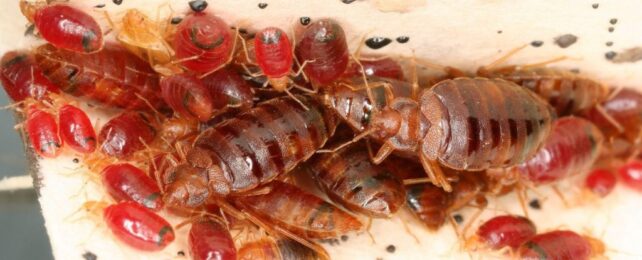A mutation that helps insects survive our chemical onslaught has been found in one of the worst places imaginable: the genome of the common bed bug.
For better or worse, we had these itchy little things under control in the wake of the chemical revolution that followed World War II, particularly with the invention of the notorious insecticide DDT that inspired the 1962 environmental science book Silent Spring and is now quite rightly banned.
But since the new millennium, bed bugs have been creeping back into our lives and jetsetting with us across the world, and some seem able to survive even the most lethal toxins in an exterminator's spraygun.
Now, a study led by entomologists from Virginia Polytechnic Institute and State University has figured out why.
There are two species of bed bug, but the most widespread is Cimex lectularius. You can learn about their life cycles and how to spot them in the video below.
Pest control companies across 22 states in the US and 4 provinces in Canada donated bugs to science, providing samples from 134 unique populations of C. lectularius that were collected between 2008 and 2022.
Bed bug populations are usually quite inbred and therefore not very genetically diverse, so the researchers needed just one representative from each group for genetic screening. Two bugs were found to have a point mutation that causes an amino acid substitution in chemical pathways associated with the nervous system.
"When we went back and screened multiple individuals from the two populations, every one of them had the mutations," Booth says.
"They were fixed for these mutations, and it's the same mutation that we find in German cockroaches."
Known as the A302S Rdl gene mutation, in cockroaches and other insects it's associated with resistance to dieldrin, an insecticide developed in the 1940s as an alternative to DDT.
That's not to say it was a good alternative: like its more infamous relative, dieldrin persists in the environment, accumulating in greater quantities up the food chain, and is implicated in several health problems. That's why it's been mostly banned since the 1980s and 1990s.
But dieldrin has a very similar composition to another insecticide, fipronil – our current weapon of choice against household fleas and roaches.
Fipronil is generally considered a more acceptable option because of its shorter half-life (although, it can still wreak havoc on bee colonies, birds, and other unfortunate bystanders). In the lab, it's proven effective against bed bugs, although it's not sold for that purpose.
The German cockroaches who developed the Rdl gene mutation, and therefore resistance to dieldrin, also became impervious to fipronil. The researchers have now found that the same goes for bed bugs, but whether this is a recent development or something dating back to fipronil's invention is anyone's guess.
"We don't know if that mutation is novel and it popped up after that, or in that time frame, or whether it was occurring in populations 100 years ago," Booth says.
Bed bugs had more than enough opportunity for exposure to cyclodienes like dieldrin before they were discontinued in the 1990s, and fipronil continues to be used in anti-flea treatment for pets.
Now the researchers have sequenced the genes of the common bed bug, they hope to get a better picture of this evolutionary timeline in future studies, by analyzing specimens from a wider range of places and time periods.
The research was published in Journal of Medical Entomology and Journal of Heredity.
